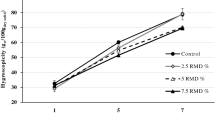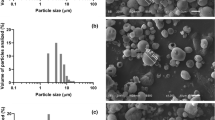Abstract
Encapsulation has been used to overcome the problem of instability of functional pigments such as carotenoids from natural sources. In this study, β-carotene in carrot juice was spray dried with four different wall materials namely maltodextrin, resistant maltodextrin, octenyl succinate anhydride (OSA) starches Capsul (CAP) and HICAP-100 (HCAP). The objective of this research was to study the effects of various wall materials on physicochemical properties and stability of β-carotene powders along with its stability after incorporation into sugar confection. All four wall materials produced powders of acceptable quality in terms of moisture content, water activity, hygroscopicity, solubility as well as onset glass transition temperature. OSA starches exhibited better pigment retention post spray drying where juices encapsulated with HCAP showed the highest retention (94.34%). This was also represented in more orange Hue values (H°) in powders produced with CAP (53.93) and HCAP (53.33). Powders produced with HCAP also showed the longest half-life after storage at 4 °C, 25 °C, and 40 °C, as well as under exposure to light. Similarly, carrot powders produced with OSA starches also exhibited better β-carotene retention after production of hard candy confection. Though candies with HCAP encapsulated juices showed the highest β-carotene retention post candy processing, candies with CAP encapsulated carrot juices exhibited better long term stability after storage at 25 °C and 40 °C as well as under exposure to light.


Similar content being viewed by others
References
Baranauskiene R, Bylaite E, Zukauskaite J, Venskutonis RP (2007) Flavor retention of peppermint (Mentha piperita L.) essential oil spray-dried in modified starches during encapsulation and storage. J Agric Food Chem 55:3027–3036
Bhandari BR, Senoussi A, Dumoulin ED, Lebert A (1993) Spray drying of concentrated fruit juices. Drying Technol 11:1081–1092
Bhosale R, Singhal R (2007) Effect of octenyl succinylation on physicochemical and functional properties of waxy maize and amaranth starches. Carbohydr Polym 68:447–456
Buck AW (2012) Resistant maltodextrin overview: chemical and physical properties. In: Cho SS, Almeida N (eds) Dietary fiber and health. CRC Press, New York, pp 279–292
Desai KGH, Park HJ (2005) Recent developments in microencapsulation of food ingredients. Drying Technol 23:1361–1394
Desobry SA, Netto FM, Labuza TP (1997) Comparison of spray-drying, drum-drying and freeze-drying for β-carotene encapsulation and preservation. J Food Sci 62:1158–1162
Dokić L, Krstonošić V, Nikolić I (2012) Physicochemical characteristics and stability of oil-in-water emulsions stabilized by OSA starch. Food Hydrocoll 29:185–192
Ergun R, Lietha R, Hartel RW (2010) Moisture and shelf life in sugar confections. Crit Rev Food Sci Nutr 50:162–192
Fang Z, Bhandari B (2012) Effect of spray drying and storage on the stability of bayberry polyphenols. Food Chem 129:1139–1147
Gharsallaoui A, Roudaut G, Chambin O, Voilley A, Saurel R (2007) Applications of spray-drying in microencapsulation of food ingredients: an overview. Food Res Int 40:1107–1121
Gu J, Ahn-Jarvis JH, Vodovotz Y (2015) Development and characterization of different black raspberry confection matrices designed for delivery of phytochemicals. J Food Sci 80:E610–E618
Kim HN, Sandhu KS, Lee JH, Lim HS, Lim ST (2010) Characterisation of 2-octen-1-ylsuccinylated waxy rice amylodextrins prepared by dry-heating. Food Chem 119:1189–1194
Lapsiri W, Bhandari B, Wanchaitanawong P (2012) Viability of Lactobacillus plantarum TISTR 2075 in different protectants during spray drying and storage. Drying Technol 30:1407–1412
Lessin WJ, Catigani GL, Schwartz SJ (1997) Quantification of cis-trans isomers of provitamin A carotenoids in fresh and processed fruits and vegetables. J Agric Food Chem 45:3728–3732
Liang R, Huang Q, Ma J, Shoemaker CF, Zhong F (2013) Effect of relative humidity on the store stability of spray-dried beta-carotene nanoemulsions. Food Hydrocoll 33:225–233
Loksuwan J (2007) Characteristics of microencapsulated b-carotene formed by spray drying with modified tapioca starch, native tapioca starch and maltodextrin. Food Hydrocoll 21:928–935
Muhammad SKS, Amin H, Bakar J (2015) Natural colorant and methods thereof. U.S. Patent No. 9,028,891
Nagao A (2004) Oxidative conversion of carotenoids to retinoids and other products. J Nutr 134:237S–240S
Nayak CA, Rastogi NK (2010) Effect of selected additives on microencapsulation of anthocyanin by spray drying. Drying Technol 28:1396–1404
Nowakowski CM, Hartel RW (2002) Moisture sorption of amorphous sugar products. J Food Sci 67:1419–1425
Paiva SA, Russell RM (1999) β-Carotene and other carotenoids as antioxidants. J Am Coll Nutr 18:426–433
Paramita V, Furuta T, Yoshii H (2012) High-oil-load encapsulation of medium-chain triglycerides and d-limonene mixture in modified starch by spray drying. J Food Sci 77:E38–E44
Pesek CA, Warthesen JJ (1990) Kinetic model for photoisomerization and concomitant photodegradation of beta-carotenes. J Agric Food Chem 38:1313–1315
Rao AV, Rao LG (2007) Carotenoids and human health. Pharmacol Res 55:207–216
Ray B, Bhunia A (2007) Fundamental food microbiology. CRC Press, New York
Risch SJ, Reineccius G. (1995) Encapsulation and controlled release of food ingredients (Vol. 590). American Chemical Society, Washington DC.
Rodríguez SD, Wilderjans TF, Sosa N, Bernik DL (2013) Image texture analysis and gas sensor array studies applied to vanilla encapsulation by octenyl succinic anhydride starches. J Food Res 2:36
Schieber A, Carle R (2005) Occurrence of carotenoid cis-isomers in food: technological, analytical, and nutritional implications. Trends Food Sci Technol 16:416–422
Shaaruddin S, Ghazali HM, Mirhosseini SH, Muhammad K (2017) Stability of betanin in pitaya powder and confection as affected by resistant maltodextrin. LWT-Food Sci Technol 84:129–134
Silaket P, Chatakanonda P, Tran T, Wansuksri R, Piyachomkwan K, Sriroth K (2014) Thermal properties of esterified cassava starches and their maltodextrins in various water systems. Starch-Stärke 66:1022–1032
Soottitantawat A, Takayama K, Okamura K, Muranaka D, Yoshii H, Furuta T, Ohkawara M, Linko P (2005) Microencapsulation of l-menthol by spray drying and its release characteristics. Innov Food Sci Emerg Technol 6:163–170
Sweedman MC, Tizzotti MJ, Schäfer C, Gilbert RG (2013) Structure and physicochemical properties of octenyl succinic anhydride modified starches: a review. Carbohydr Polym 92:905–920
Teixeira MI, Andrade LR, Farina M, Rocha-Leão MHM (2004) Characterization of short chain fatty acid microcapsules produced by spray drying. Mater Sci Eng C 24:653–658
Wagner LA, Warthesen JJ (1995) Stability of spray-dried encapsulated carrot carotenes. J Food Sci 60:1048–1053
Westergaard V (2004) Milk powder technology—evaporation and spray drying. GEA A/S Niro, Copenhagen
Wijaya M, Small DM, Bui L (2011) Microencapsulation of ascorbic acid for enhanced long-term retention during storage. Technical report number DSTO-TR-2504 Division, Defence Science and Technology Organisation, Fishermans Bend, Victoria
Acknowledgements
The authors would like to acknowledge the financial support provided by Universiti Putra Malaysia (6360600).
Author information
Authors and Affiliations
Corresponding author
Additional information
Publisher's Note
Springer Nature remains neutral with regard to jurisdictional claims in published maps and institutional affiliations.
Rights and permissions
About this article
Cite this article
Shaaruddin, S., Mahmood, Z., Ismail, H. et al. Stability of β-carotene in carrot powder and sugar confection as affected by resistant maltodextrin and octenyl succinate anhydride (OSA) starches. J Food Sci Technol 56, 3461–3470 (2019). https://doi.org/10.1007/s13197-019-03832-4
Revised:
Accepted:
Published:
Issue Date:
DOI: https://doi.org/10.1007/s13197-019-03832-4




